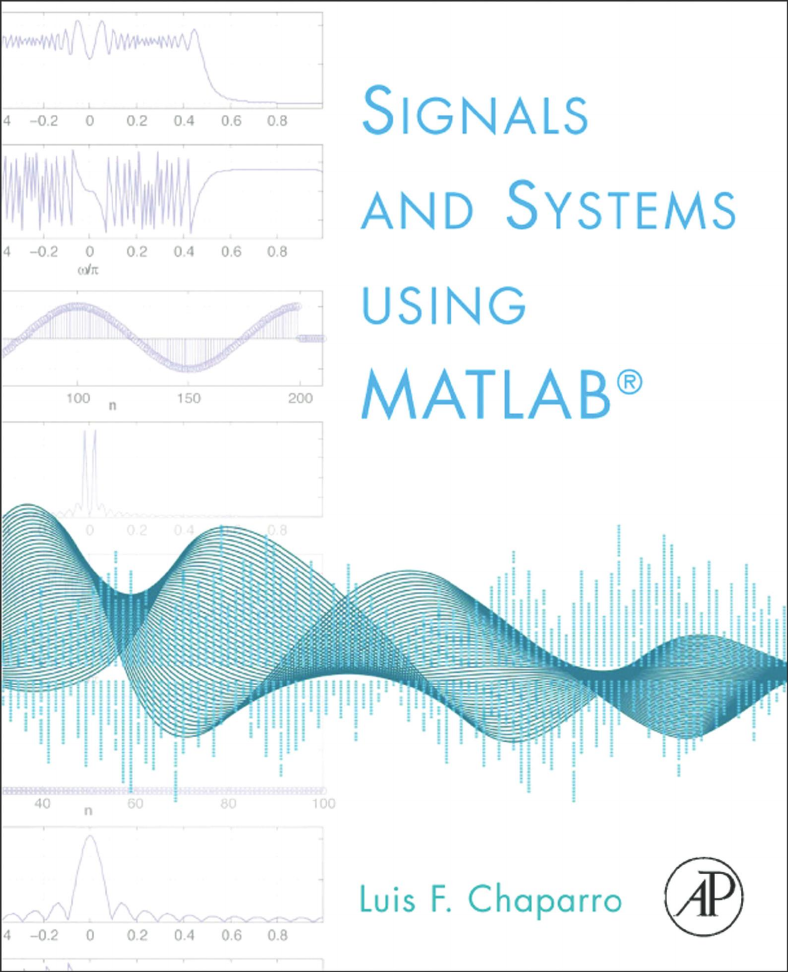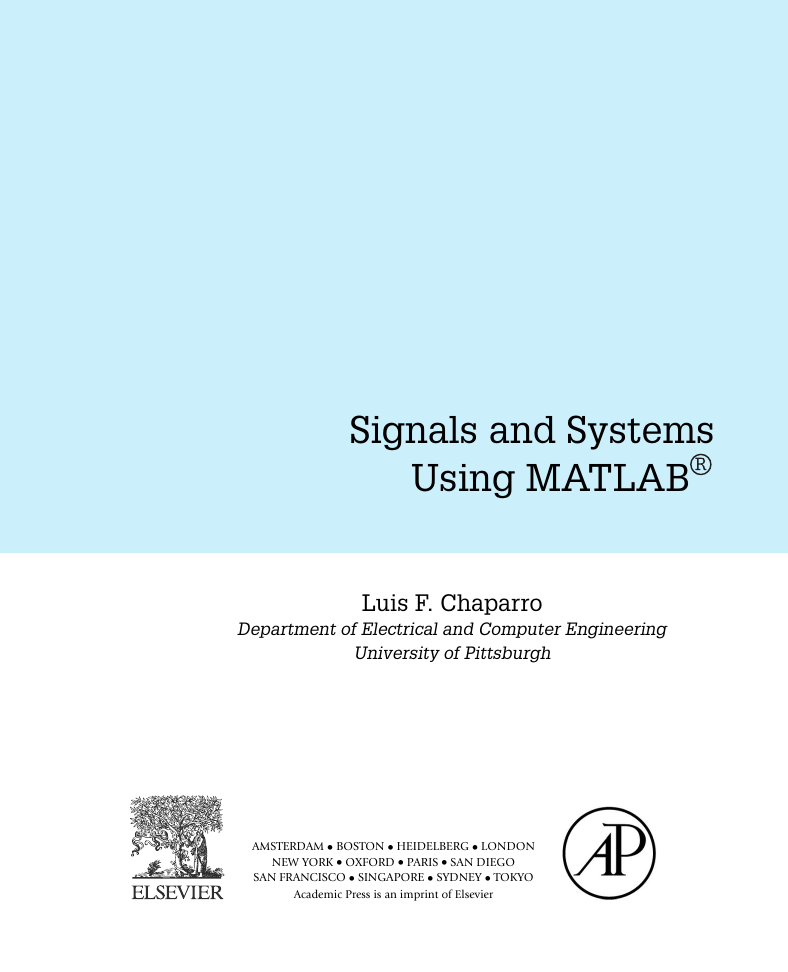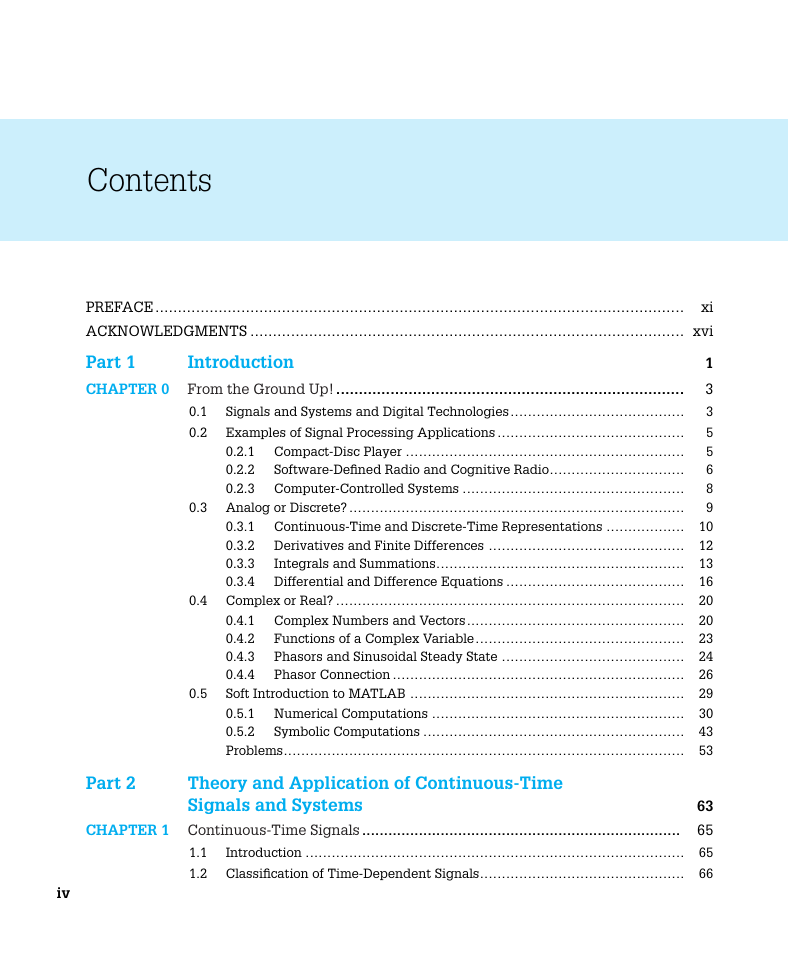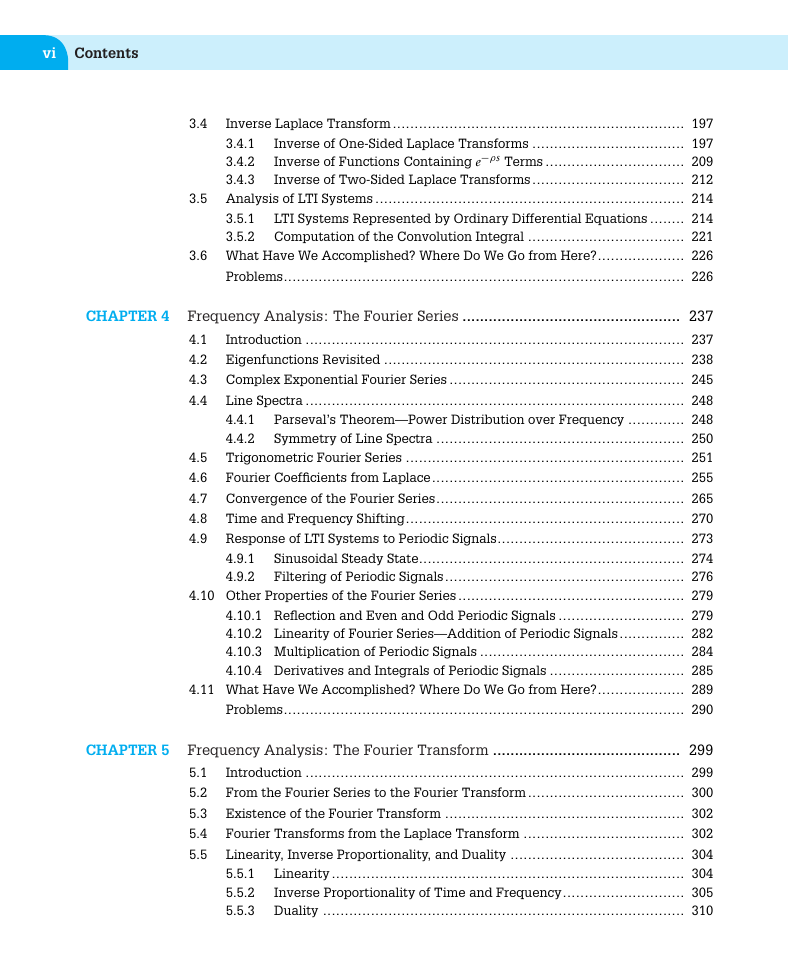Front cover
Signals and Systems Using MATLAB®
Copyright page
Dedication
Table of contents
Preface
Acknowledgments
Part 1: Introduction
Chapter 0. From the Ground Up!
0.1 Signals and Systems and Digital Technologies
0.2 Examples of Signal Processing Applications
0.3 Analog or Discrete?
0.4 Complex or Real?
0.5 Soft Introduction to MATLAB
Problems
Part 2: Theory and Application of Continuous-Time Signals and Systems
Chapter 1. Continuous-Time Signals
1.1 Introduction
1.2 Classification of Time-Dependent Signals
1.3 Continuous-Time Signals
1.4 Representation Using Basic Signals
1.5 What Have We Accomplished? Where Do We Go from Here?
Problems
Chapter 2. Continuous-Time Systems
2.1 Introduction
2.2 System Concept
2.3 LTI Continuous-Time Systems
2.4 What Have We Accomplished? Where Do We Go from Here?
Problems
Chapter 3. The Laplace Transform
3.1 Introduction
3.2 The Two-Sided Laplace Transform
3.3 The One-Sided Laplace Transform
3.4 Inverse Laplace Transform
3.5 Analysis of LTI Systems
3.6 What Have We Accomplished? Where Do We Go from Here?
Problems
Chapter 4. Frequency Analysis: The Fourier Series
4.1 Introduction
4.2 Eigenfunctions Revisited
4.3 Complex Exponential Fourier Series
4.4 Line Spectra
4.5 Trigonometric Fourier Series
4.6 Fourier Coefficients from Laplace
4.7 Convergence of the Fourier Series
4.8 Time and Frequency Shifting
4.9 Response of LTI Systems to Periodic Signals
4.10 Other Properties of the Fourier Series
4.11 What Have We Accomplished? Where Do We Go from Here?
Problems
Chapter 5. Frequency Analysis: The Fourier Transform
5.1 Introduction
5.2 From the Fourier Series to the Fourier Transform
5.3 Existence of the Fourier Transform
5.4 Fourier Transforms from the Laplace Transform
5.5 Linearity, Inverse Proportionality, and Duality
5.6 Spectral Representation
5.7 Convolution and Filtering
5.8 Additional Properties
5.9 What have We Accomplished? What is next?
Problems
Chapter 6. Application to Control and Communications
6.1 Introduction
6.2 System Connections and Block Diagrams
6.3 Application to Classic Control
6.4 Application to Communications
6.5 Analog Filtering
6.6 What Have We Accomplished? What is next?
Problems
Part 3: Theory and Application of Discrete-Time Signals and Systems
Chapter 7. Sampling Theory
7.1 Introduction
7.2 Uniform Sampling
7.3 The Nyquist-Shannon Sampling Theorem
7.4 Practical Aspects of Sampling
7.5 What Have We Accomplished? Where Do We Go from Here?
Problems
Chapter 8. Discrete-Time Signals and Systems
8.1 Introduction
8.2 Discrete-Time Signals
8.3 Discrete-Time Systems
8.4 What Have We Accomplished? Where Do We Go from Here?
Problems
Chapter 9. The Z-Transform
9.1 Introduction
9.2 Laplace Transform of Sampled Signals
9.3 Two-Sided Z-Transform
9.4 One-Sided Z-Transform
9.5 One-Sided Z-Transform Inverse
9.6 What Have We Accomplished? Where Do We Go from Here?
Problems
Chapter 10. Fourier Analysis of Discrete-Time Signals and Systems
10.1 Introduction
10.2 Discrete-Time Fourier Transform
10.3 Fourier Series of Discrete-Time Periodic Signals
10.4 Discrete Fourier Transform
10.5 What Have We Accomplished? Where Do We Go from Here?
Problems
Chapter 11. Introduction to the Design of Discrete Filters
11.1 Introduction
11.2 Frequency-Selective Discrete Filters
11.3 Filter Specifications
11.4 IIR Filter Design
11.5 FIR Filter Design
11.6 Realization of Discrete Filters
11.7 What Have We Accomplished? Where Do We Go from Here?
Problems
Chapter 12. Applications of Discrete-Time Signals and Systems
12.1 Introduction
12.2 Application to Digital Signal Processing
12.3 Application to Sampled-Data and Digital Control Systems
12.4 Application to Digital Communications
12.5 What Have We Accomplished? Where Do We Go from Here?
Appendix. Useful Formulas
Bibliography
Index
















 2023年江西萍乡中考道德与法治真题及答案.doc
2023年江西萍乡中考道德与法治真题及答案.doc 2012年重庆南川中考生物真题及答案.doc
2012年重庆南川中考生物真题及答案.doc 2013年江西师范大学地理学综合及文艺理论基础考研真题.doc
2013年江西师范大学地理学综合及文艺理论基础考研真题.doc 2020年四川甘孜小升初语文真题及答案I卷.doc
2020年四川甘孜小升初语文真题及答案I卷.doc 2020年注册岩土工程师专业基础考试真题及答案.doc
2020年注册岩土工程师专业基础考试真题及答案.doc 2023-2024学年福建省厦门市九年级上学期数学月考试题及答案.doc
2023-2024学年福建省厦门市九年级上学期数学月考试题及答案.doc 2021-2022学年辽宁省沈阳市大东区九年级上学期语文期末试题及答案.doc
2021-2022学年辽宁省沈阳市大东区九年级上学期语文期末试题及答案.doc 2022-2023学年北京东城区初三第一学期物理期末试卷及答案.doc
2022-2023学年北京东城区初三第一学期物理期末试卷及答案.doc 2018上半年江西教师资格初中地理学科知识与教学能力真题及答案.doc
2018上半年江西教师资格初中地理学科知识与教学能力真题及答案.doc 2012年河北国家公务员申论考试真题及答案-省级.doc
2012年河北国家公务员申论考试真题及答案-省级.doc 2020-2021学年江苏省扬州市江都区邵樊片九年级上学期数学第一次质量检测试题及答案.doc
2020-2021学年江苏省扬州市江都区邵樊片九年级上学期数学第一次质量检测试题及答案.doc 2022下半年黑龙江教师资格证中学综合素质真题及答案.doc
2022下半年黑龙江教师资格证中学综合素质真题及答案.doc